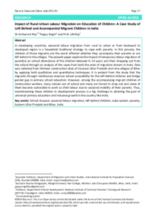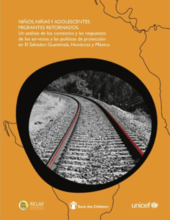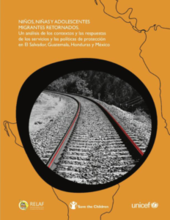Displaying 761 - 770 of 836
The overall objective of this research was to increase understanding of kinship care practices as experienced by Syrian refugee children and caregivers in Jordan, which can be used to inform programming and policy developments on children’s care and protection in a humanitarian context.
This article from the Migration Policy Institute examines the impact of labor migration on children who are left behind, from an economic and social lens, and with particular attention to gendered implications.
This study aims to bridge gaps in areas of knowledge by quantitatively investigating the association between transnational families and children's psychological well-being. It analyzes a survey conducted in three African countries in 2010-11 (Ghana, Angola, and Nigeria) amongst pupils of secondary schools, comparing children in transnational families to those living with their parents in their country of origin.
This paper explores the impact of temporary labour migration of parent(s) on school attendance of children between 6–14 years and their dropping out from school through an analysis of cases from both ends of the migration stream in India - children accompanying their migrant parents and children left behind.
Esta evaluación rápida, conducida por RELAF in colaboración con Save the Children y UNICEF, revisa las políticas públicas y servicios desarrollados por instituciones gubernamentales y no-gubernamentales perteneciendo al "Sistema de Protección Integral" para hacer frente a las cuestiones problemáticas que afectan los niños migrantes y sus familias en el Triángulo del Norte (El Salvador, Guatemala, y Honduras) y México.
This article discusses the effect of international migration on the accumulation of human capital among Mexican youths aged 15–18 who are left behind.
Entre 2013 y 2014, aumentó de manera considerable el número de niños, niñas y adolescentes no acompañados que migran desde los países de América Central hacia México y los Estados Unidos (EU).
Esta evaluación rápida busca cubrir la escasez de información sobre las políticas y los servicios de las entidades gubernamentales y no gubernamentales encargadas de la protección de los derechos de niños, niñas y adolescentes migrantes retornados a sus sociedades de origen en los países del Triángulo del Norte y México, con un foco en las acciones tendientes a restituir el derecho a la convivencia familiar y la integración comunitaria.
This paper explores the effects of a mother’s migration on her children’s well-being.
This paper uses data collected in 2008 and 2009 for a project on Child Health and Migrant Parents in South-East Asia (CHAMPSEA) to address a largely neglected research area by investigating the mental health of those who stay behind in Indonesia, Philippines and Vietnam to care for the children of overseas migrants.





